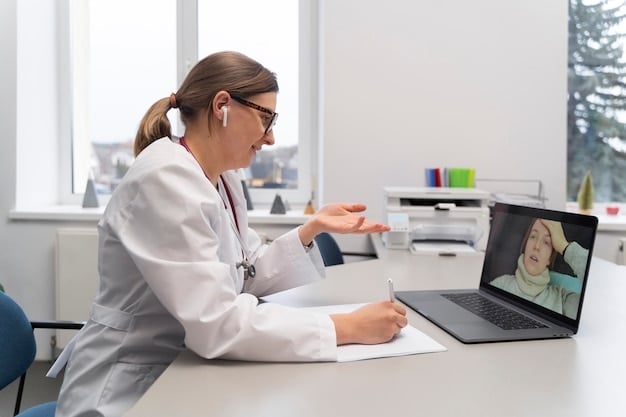Telehealth Expansion: US Federal Regulations for Remote Patient Monitoring

The latest US federal regulations significantly reshape telehealth, promoting broader adoption of remote patient monitoring by expanding coverage, easing restrictions, and clarifying reimbursement, marking a pivotal shift in healthcare delivery.
The landscape of healthcare in the United States is undergoing a profound transformation, with Telehealth Expansion: What the Latest Federal Regulations Mean for Remote Patient Monitoring in the US standing at the forefront of this evolution. As technology continues to advance, so too does our ability to deliver care remotely, offering unprecedented convenience and accessibility. This pivotal shift, particularly in remote patient monitoring (RPM), brings both exciting opportunities and complex regulatory challenges that demand careful consideration and understanding.
Understanding the Landscape of Telehealth Before Regulation
Before delving into the specifics of recent federal regulations, it is crucial to appreciate the environment that necessitated these changes. Telehealth, broadly defined as the use of electronic information and telecommunications technologies to support long-distance clinical healthcare, patient and professional health-related education, public health, and health administration, has been a concept for decades. However, its widespread adoption faced significant hurdles, primarily due to a patchwork of state-level laws, restrictive reimbursement policies, and a general lack of clarity on what services could be delivered remotely and how they would be compensated.
Remote Patient Monitoring (RPM) specifically, involves the use of digital technologies to collect health data from individuals in one location and electronically transmit that information securely to healthcare providers in a different location for assessment and recommendations. This can include monitoring vital signs, blood glucose levels, cardiac rhythms, and more. Historically, the promise of RPM was evident, offering the potential to manage chronic conditions more effectively, reduce hospital readmissions, and improve patient outcomes away from traditional clinical settings. Yet, its implementation was often hampered by the absence of coherent federal guidance.
Medicare, the largest healthcare payer in the US, traditionally had very stringent rules regarding telehealth. Services were largely restricted to rural areas, and only certain types of providers and specific care settings were eligible for reimbursement. Physicians faced a maze of CPT codes and billing modifiers, making it difficult to integrate RPM into their practices without significant administrative burden and financial risk. This restrictive environment meant that despite technological readiness and patient need, the full potential of telehealth and RPM remained largely untapped.
The Impact of the COVID-19 Pandemic on Telehealth Adoption
The COVID-19 pandemic acted as an unprecedented catalyst for telehealth, forcing a rapid, widespread adoption out of necessity. As clinics closed their doors and patients feared in-person visits, federal and state governments quickly waived many of the previous restrictions. This emergency response allowed healthcare providers to maintain continuity of care and demonstrated the immense value and feasibility of remote services. It provided real-world data showing that telehealth could be effective, safe, and widely accepted by both patients and providers. This period of rapid expansion laid the groundwork for the more permanent regulatory changes we see today, highlighting the need for a more sustainable and flexible framework. The experience gained during the pandemic proved invaluable in shaping policy discussions.
- Increased Patient Access: Telehealth bridged gaps for vulnerable populations and those in underserved areas.
- Reduced Disease Transmission: Minimized exposure risks for both patients and healthcare workers.
- Enhanced Care Continuity: Allowed ongoing management of chronic conditions despite lockdowns.
This forced paradigm shift not only proved the viability of telehealth but also exposed the critical need for comprehensive regulatory reform that could support its long-term integration into the healthcare system, moving beyond emergency waivers to a more permanent, strategic implementation.
Key Federal Regulations Shaping Telehealth Expansion
The recent wave of federal regulations marks a pivotal moment for telehealth and remote patient monitoring in the US, transitioning from an emergency-driven expansion to a more structured and sustainable framework. These rules, primarily stemming from the Centers for Medicare & Medicaid Services (CMS) and Congress, aim to solidify telehealth’s role in healthcare delivery. The primary goal is to ensure that the innovations accelerated by the pandemic can continue to benefit patients and providers, while also maintaining appropriate safeguards and quality standards.
One of the most significant changes involves the permanent expansion of eligible telehealth services under Medicare. Prior to the pandemic, many services were only reimbursable if delivered in specific geographic locations or under particular circumstances. The new regulations have largely removed these geographic restrictions and expanded the list of CPT (Current Procedural Terminology) codes eligible for telehealth reimbursement. This means that a wider array of medical services can now be provided remotely, fostering greater access to care for millions of Americans, regardless of their location.
Billing and Reimbursement Flexibilities for RPM
For Remote Patient Monitoring (RPM), the regulations have brought much-needed clarity and flexibility to billing and reimbursement. CMS has refined codes for RPM services, making it easier for providers to understand what can be billed and how. This includes separate codes for initial setup and patient education, daily remote monitoring, and interactive communication. The ability to bill for these distinct components of RPM encourages its adoption by ensuring providers are adequately compensated for their time and resources.
- Expanded CPT Codes: More services now qualify for telehealth reimbursement.
- Clarified Billing Rules: Specific guidelines for initial setup, daily monitoring, and communication.
- Removed Geographic Restrictions: Telehealth services no longer limited to rural areas for many conditions.
These changes are designed to reduce the administrative burden on providers and encourage them to integrate RPM into their care models. By providing a clear financial pathway, the federal government signals its commitment to making RPM a standard part of chronic disease management and preventive care, thereby potentially improving patient outcomes and reducing healthcare costs in the long run.
Beyond Medicare, other federal agencies, such as the Health Resources and Services Administration (HRSA), have also played a role in promoting telehealth through various grants and initiatives aimed at underserved communities. These parallel efforts ensure that the expansion of telehealth is equitable and reaches those who need it most, complementing the CMS’s reimbursement reforms with practical support for implementation.

Impact on Healthcare Providers and Systems
The latest federal regulations concerning telehealth expansion and remote patient monitoring are profoundly reshaping how healthcare providers operate and how health systems deliver care. For many years, the adoption of telehealth was a “nice-to-have” option, often seen as an adjunct to traditional in-person visits. Now, with a clearer regulatory framework and more robust reimbursement policies, it is rapidly becoming an integral part of standard medical practice. This shift necessitates significant adjustments across the board, from clinical workflows to technological infrastructure and staff training.
Providers, particularly those specializing in chronic disease management, mental health, and primary care, are finding new avenues to engage with their patients. RPM, for instance, allows for continuous data collection, enabling more proactive interventions rather than reactive treatments. This data-driven approach supports personalized care plans and can lead to better health outcomes, fewer emergency room visits, and hospitalizations. Clinicians can monitor vital signs, glucose levels, and other critical metrics from afar, receiving alerts when readings fall outside normal parameters, thus empowering timely clinical decision-making. This continuous oversight helps foster a stronger therapeutic relationship, as patients feel more supported and engaged in their own health journey.
Operational Changes and Infrastructure Needs
Implementing widespread telehealth and RPM requires substantial operational modifications within healthcare systems. This includes investing in secure, interoperable technology platforms that can handle virtual visits, transmit patient data securely, and integrate seamlessly with existing electronic health records (EHRs). Training staff—from front-desk personnel to nurses and physicians—on these new technologies and workflows is also paramount. Ensuring that administrative processes, such as scheduling, billing, and technical support, are streamlined for remote services is crucial for successful adoption and patient satisfaction.
- Technology Integration: Need for secure platforms compatible with EHRs.
- Staff Training: Essential for effective use of new telehealth tools and workflows.
- Workflow Optimization: Redesigning processes for virtual appointments and data management.
Healthcare systems are also exploring innovative models of care delivery that leverage telehealth. This could involve “hospital at home” programs, where patients receive acute-level care in their residences, or enhanced chronic care management programs supported by RPM devices. The ability to extend care beyond the traditional clinic walls not only improves patient access but also has the potential to optimize resource allocation, alleviate overcrowded facilities, and enhance efficiency across the healthcare ecosystem. The long-term implications point towards a more distributed, patient-centric healthcare model.
Benefits for Patients and Access to Care
The expansion of telehealth, particularly through remote patient monitoring (RPM), under the latest federal regulations ushers in a new era of benefits for patients across the United States. One of the most immediate and profound advantages is the dramatic improvement in access to care. For individuals residing in rural or underserved areas, where specialists and even general practitioners may be scarce, telehealth removes geographical barriers. Patients no longer face arduous commutes, expensive travel, or long waiting lists, making healthcare more attainable and less burdensome.
Beyond geographical considerations, telehealth significantly enhances convenience. Patients can now receive consultations, follow-up care, and even certain diagnostic services from the comfort of their homes or workplaces. This flexibility is invaluable for those with mobility issues, chronic conditions that make travel difficult, or individuals with demanding work schedules. The ability to avoid taking time off work, arranging childcare, or dealing with transportation logistics translates into a more patient-friendly healthcare experience, ultimately encouraging greater adherence to treatment plans and preventive care.
Improved Management of Chronic Conditions
For patients managing chronic conditions such as diabetes, heart disease, or hypertension, remote patient monitoring is a game-changer. RPM devices continuously collect vital health data, such as blood pressure, glucose levels, weight, and oxygen saturation, transmitting it directly to their healthcare providers. This constant oversight allows for early detection of concerning trends or deviations, enabling quicker adjustments to medication or treatment plans. Instead of relying on periodic office visits to inform care, providers have a real-time understanding of a patient’s health status, leading to more personalized and effective interventions.
- Real-time Data: Continuous monitoring helps detect issues promptly.
- Proactive Care: Enables timely adjustments to treatment plans.
- Reduced Hospitalizations: Better management can prevent acute exacerbations.
The proactive nature of RPM empowers patients to play a more active role in their health management. Receiving regular feedback from their providers based on their own data can lead to increased health literacy and self-efficacy. Patients feel more engaged and in control, knowing that their health is being consistently monitored and that support is readily available. This collaborative approach enhances the patient-provider relationship, fostering trust and promoting sustained health improvements. Ultimately, the expansion of telehealth and RPM creates a healthcare system that is more responsive, accessible, and centered around the individual’s needs.
Challenges and Future Considerations
While the recent federal regulations have undeniably propelled telehealth and remote patient monitoring forward, their implementation is not without challenges, and the future landscape still holds several critical considerations. One of the primary concerns revolves around digital disparities and equitable access. Despite the promise of telehealth to bridge gaps, not all Americans have reliable access to high-speed internet or the necessary devices. This digital divide could inadvertently exacerbate existing health inequities, leaving vulnerable populations further behind if not adequately addressed through targeted initiatives and infrastructure investments.
Another significant challenge lies in data privacy and cybersecurity. As more patient health information is transmitted electronically and stored in cloud-based systems, the risk of data breaches and cyberattacks increases. Ensuring the secure transmission and storage of sensitive medical data is paramount to maintaining patient trust and complying with stringent regulations like HIPAA. Healthcare organizations must continually invest in robust cybersecurity measures and employee training to protect against evolving threats, safeguarding patient confidentiality at every touchpoint.
Ensuring Quality and Clinical Effectiveness
Beyond technical and access issues, rigorous evaluation of the quality and clinical effectiveness of telehealth and RPM services remains a crucial future consideration. While emergency waivers during the pandemic highlighted the utility of these services, ongoing research is needed to establish best practices, compare outcomes with in-person care, and define appropriate use cases. This involves developing standardized metrics for evaluating patient satisfaction, clinical efficacy, and cost-effectiveness of remote interventions. Payers and policymakers will continue to rely on this evidence to refine reimbursement policies and ensure that telehealth delivers genuine value.
- Digital Divide: Unequal access to technology and internet for some populations.
- Data Security: Protecting sensitive patient information from cyber threats.
- Clinical Validation: Ongoing research to prove effectiveness and establish best practices.
Furthermore, workforce development is a key area for future planning. Healthcare professionals require specialized training in telehealth etiquette, technology utilization, and remote patient assessment techniques. Medical education programs will need to adapt to incorporate these competencies, ensuring new graduates are well-equipped for a hybrid care delivery model. Addressing licensure portability across state lines continues to be an issue, as current regulations often complicate providers’ ability to care for patients in different states. Harmonizing these regulations will be vital for a truly national telehealth infrastructure. The journey towards fully integrated and optimized telehealth is ongoing, requiring continuous adaptation and collaborative effort from all stakeholders.
Compliance and Regulatory Frameworks for RPM
Navigating the complex web of compliance and regulatory frameworks is paramount for any healthcare provider or technology company engaging in Remote Patient Monitoring (RPM) within the US. The latest federal regulations have brought much-needed clarity, but they also underscore the responsibility of all stakeholders to adhere to established guidelines. At the core of RPM compliance is adherence to the Health Insurance Portability and Accountability Act (HIPAA), which mandates strict protections for patient health information. This means ensuring that all RPM platforms, data transmission, and storage methods are secure, encrypted, and designed to prevent unauthorized access or disclosure.
Beyond HIPAA, providers must also consider state-specific regulations that may govern telehealth and RPM. While federal rules provide a baseline, individual states often have additional requirements concerning licensure, informed consent, and prescribing practices for remote care. It is crucial for providers to be aware of and comply with both federal and state laws to avoid potential penalties and legal issues. The evolving nature of these regulations necessitates ongoing monitoring and adaptation of practices to remain compliant in a dynamic environment.
Billing and Documentation Requirements
One of the most critical aspects of compliance for RPM relates to billing and documentation. The Centers for Medicare & Medicaid Services (CMS) has specific CPT codes and guidelines for how RPM services should be billed and what documentation is required to support those claims. This includes recording the time spent on device setup, patient education, daily physiological monitoring, and interactive communication with the patient. Accurate and thorough documentation is not just a best practice; it is a necessity for legitimate reimbursement and to demonstrate the medical necessity of the services provided.
- HIPAA Compliance: Strict adherence to patient data privacy and security.
- State-Specific Laws: Awareness and compliance with varying state regulations.
- Accurate Documentation: Detailed records for billing and medical necessity.
Furthermore, the FDA (Food and Drug Administration) plays a role in regulating the RPM devices themselves. Devices used for remote patient monitoring must often meet specific safety and efficacy standards set forth by the FDA, especially if they are classified as medical devices. Providers and technology developers must ensure that the equipment used is approved and functions as intended, providing accurate data for clinical decision-making. Staying abreast of these multifaceted regulatory requirements is vital for sustainable and ethical RPM implementation, fostering an environment of trust and accountability within the expanding telehealth ecosystem.
Future Outlook for Telehealth and RPM in the US
The future outlook for telehealth and Remote Patient Monitoring (RPM) in the US is undeniably bright, largely thanks to the foundational shifts introduced by the latest federal regulations. These changes have propelled what was once a niche aspect of healthcare into a mainstream mode of care delivery, setting the stage for continued innovation and integration. We can anticipate further advancements in technology that will make RPM devices even more sophisticated, user-friendly, and capable of monitoring a wider array of physiological parameters. This technological evolution will likely extend the reach of remote care to more complex conditions and facilitate proactive interventions that were previously unimaginable.
One key trend to watch is the increasing integration of artificial intelligence (AI) and machine learning (ML) into RPM platforms. AI algorithms could analyze vast amounts of patient data from RPM devices, identify subtle trends or early warning signs, and even predict potential health crises before they become acute. This predictive capability has the potential to revolutionize preventive care, allowing providers to intervene earlier and with greater precision, thereby improving patient outcomes and reducing healthcare costs significantly. Such intelligent systems would elevate RPM from data collection to sophisticated decision support.
Policy Evolution and Expanded Coverage
On the policy front, it is highly probable that federal and state governments will continue to refine and expand regulations to support telehealth and RPM. This could include further clarification on reimbursement for asynchronous (store-and-forward) telehealth, as well as addressing current limitations on cross-state licensure for providers. There is a growing recognition that a harmonized regulatory environment is essential for maximizing the benefits of remote care and creating a truly national telehealth infrastructure. As more evidence emerges regarding the effectiveness and cost-savings of telehealth, we can expect broader coverage from both public and private payers, ensuring greater financial sustainability for these services.
- Technological Advancements: More sophisticated and integrated RPM devices.
- AI and Machine Learning: Predictive analytics for early intervention and personalized care.
- Policy Harmonization: Streamlined state and federal regulations for broader adoption.
The emphasis on value-based care models will also likely drive further adoption of RPM. Payers are increasingly incentivizing providers for achieving better patient outcomes and reducing overall costs, and RPM offers a powerful tool to meet these objectives through continuous monitoring and proactive management. This shift in payment models naturally aligns with the strengths of remote care, promoting its use as a core strategy for achieving population health goals. Ultimately, the future of telehealth and RPM in the US points towards a more personalized, accessible, and efficient healthcare system, firmly established as a cornerstone of modern medical practice.
| Key Point | Brief Description |
|---|---|
| 🚀 Expanded Access | New federal rules remove many geographical limits, making telehealth available to more patients, especially in rural areas. |
| 💰 Reformed Reimbursement | CMS has clarified billing for Remote Patient Monitoring (RPM) services, encouraging provider adoption through better compensation. |
| 🛡️ Compliance Focus | HIPAA, state laws, and FDA device regulations remain critical for secure, ethical, and effective telehealth and RPM operations. |
| 📈 Future Growth | Expect more tech integration (AI/ML) and policy harmonization, driving further expansion and improved patient outcomes. |
Frequently Asked Questions About Telehealth Regulations
The primary changes include the permanent expansion of eligible telehealth services under Medicare, relaxed geographic restrictions, and clarified billing and reimbursement policies for Remote Patient Monitoring (RPM). These updates aim to integrate telehealth more deeply into standard healthcare practices, enhancing patient access and provider compensation for remote services.
For RPM, the regulations provide clearer CPT codes and reimbursement guidelines for various services, such as initial device setup, patient education, daily monitoring, and interactive communications. This financial clarity encourages more providers to adopt RPM, facilitating better management of chronic conditions and improving patient health outcomes away from traditional clinical settings.
No, one of the most significant aspects of the new federal regulations is the removal of many previous geographic restrictions for telehealth services under Medicare. This expansion means a wider array of medical services can now be provided remotely to patients regardless of their location, greatly increasing access to care for both urban and rural populations.
Key challenges include addressing the digital divide to ensure equitable access, strengthening cybersecurity measures for patient data, and conducting ongoing research to affirm clinical effectiveness. Additionally, workforce training for telehealth competencies and harmonizing state-specific licensure laws are crucial for optimizing future adoption and integration.
HIPAA remains a cornerstone of telehealth and RPM compliance. All platforms, data transmissions, and storage methods associated with remote care must adhere strictly to HIPAA’s provisions for protecting patient health information. This ensures the confidentiality, integrity, and security of sensitive medical data, maintaining patient trust in remote healthcare services.
Conclusion
The recent federal regulations concerning Telehealth Expansion: What the Latest Federal Regulations Mean for Remote Patient Monitoring in the US represent a transformative stride in American healthcare. By broadening access, clarifying reimbursement, and solidifying the operational framework for remote care, these policies are not merely a reaction to a public health crisis but a deliberate push towards a more accessible, efficient, and patient-centric healthcare system. While challenges such as digital equity, data security, and ongoing clinical validation persist, the foundational shifts brought about by these regulations have undeniably set a robust course for the sustained growth and integration of telehealth and remote patient monitoring into mainstream medical practice. The future promises continued innovation, greater patient empowerment, and a healthcare landscape where quality care is increasingly defined by its reach and responsiveness, extending far beyond the traditional confines of a clinic.





